
Okra is a Southern staple in the home garden and at the dinner table and can be grown throughout the state of Georgia. It is considered a warm season vegetable and is a member of the Mallow family, which includes plants such as cotton and hibiscus. This vegetable is both easy and fun to grow and can be used in many different culinary dishes and for dried flower arrangements.
Sites and Soils
Okra prefers well-drained, sandy soils that are high in organic matter, but it can be grown in a wide variety of soils. Okra can tolerate a pH range from 5.8 to 6.8. Okra does best when planted in a full sun area. Align the rows in an east/west direction to capture maximum sunlight. Only plant when soils have warmed up to at least 65 degrees F at a 4-inch depth.
Planting
Okra can be established by sowing seeds directly into the garden. To enhance germination, soak okra seeds in water for several hours or overnight before sowing. Space rows 3-feet apart; sow seeds 1-inch deep and 4- to 6-inches apart within the row. When seedlings are several inches tall, thin the row so the remaining plants are spaced 1.5- to 2-feet apart.
Fertilization
Before planting, have the soil tested at the local County Extension office and follow any recommendations. With no soil test, a general recommendation would be to apply 2 pounds of 10-10-10 per 100 square feet and make two sidedressings of 3 ounces of 10-10-10 per 100 feet of row, beginning when plants are 6- to 8-inches tall and again two to three weeks later. Additional sidedressing may be needed if heavy rains occur. Do not over-use nitrogen, since it can cause excessive vegetative growth with poor yield.
Watering
Okra can tolerate dry conditions; however, watering may be necessary during extended dry periods. Moisture is especially important during flowering and pod development. During prolonged dry periods, a deep soaking once every seven to 10 days with 1 to 1.5 inches of water should be adequate. Soaker hoses or drip irrigation tape are the best methods for applying water.
Cultivation and Weed Control
Okra is harvested over a long period of time and full-season weed control is important. Where mechanical cultivation is necessary, it should be shallow and done only as often as required to control weeds. Organic mulches help control weeds and conserve moisture.
Harvest and Storage
Okra should be ready to harvest about 60 to 70 days after planting, when pods are 2- to 3-inches long. At this stage the pods are still tender. Larger okra pods will become too tough and fibrous. Round-podded okra varieties remain tender at larger pod sizes and are good to use for slicing and freezing.
Okra grows very fast; therefore, it must be harvested every few days. Do not allow pods to mature on the plant because this will slow production and cause tough, fibrous pods. Handle okra carefully because the pods bruise easily.
The optimum conditions for storing okra are a moist environment and temperatures of 45 to 50 degrees F. Okra can be stored in the refrigerator for about seven days.
Insect Control
The insects found on okra vary from year to year, but various beetles (flea, Japanese, blister and cucumber beetles) and worms (mostly corn earworm) are generally the most common. Inspect plants frequently and treat with an approved product if needed.
Disease Control
The more serious okra disease pests include rootknot nematode, Southern stem blight and wilt. A combination of crop rotation and good soil management is important for controlling these diseases. Foliage blights may occur, but generally they do not reach a level that requires treatment. Blossom blight can be serious during persistent rainy periods.
Suggested Varieties
Several okra varieties (cultivars) are available to home gardeners and differ in plant size and fruit characteristics. Most varieties produce spineless pods. Some suggested varieties are listed below.
| Annie Oakley II | hybrid | spineless | dark green pods | 4.5-foot-tall plants |
| Burgundy | open pollinated | burgundy red pods | 4-foot-tall plants | |
| Cajun Delight | hybrid | spineless | dark green pods | 4-foot-tall plants |
| Clemson Spineless | open pollinated | spineless | dark green pods | 4- to 5-foot-tall plants |
Status and Revision History
Published on Aug 14, 2008
Published on May 13, 2011
Published with Full Review on Aug 01, 2014
Published with Full Review on Jul 07, 2022


























































